How Muon Tomography can fit into the Customs data ecosystem
31 October 2024
By Kevin Davies, Decision Sciences International Corporation (DSIC)Threats to the security and general well-being of people all over the world are increasing. Given the internationalization of today’s supply chains, countering many of these threats requires governments to rigorously control trade operations at import, export and transit. One recurring issue is identifying shipments containing prohibited or smuggled goods, which is somewhat like searching for the proverbial “needle in a haystack” for Customs officers.
To enhance their capacity in this domain, Customs administrations have been leveraging Non-Intrusive Inspection (NII) technologies, including conventional high energy X-ray systems. One NII technology recently applied to cargo inspection offers new and unique capabilities: Muon Tomography. It offers unparalleled penetration to effectively screen the densest of material and cargo, exceeding the capabilities of X-ray systems, but is not harmful to humans and requires no shielding whatsoever. Furthermore, and equally importantly, it leverages Deep Learning (DL) algorithms to accurately identify anomalies in cargo.
About Muon Tomography
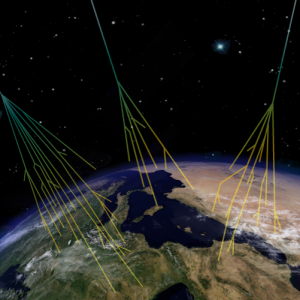 Primary Cosmic Rays shatter in the Earth’s atmosphere to produce a continuous and harmless flux of muons and electrons. These particles are constantly raining down onto Earth’s surface from the atmosphere 24 hours a day, 7 days a week. On average, at sea level, over 5000 muons and 2000 electrons pass through your body every minute, which also equates to 1 muon per square centimetre per minute.
Primary Cosmic Rays shatter in the Earth’s atmosphere to produce a continuous and harmless flux of muons and electrons. These particles are constantly raining down onto Earth’s surface from the atmosphere 24 hours a day, 7 days a week. On average, at sea level, over 5000 muons and 2000 electrons pass through your body every minute, which also equates to 1 muon per square centimetre per minute.
Muon Tomography harnesses the characteristics of these two particles to produce three-dimensional data-rich imagery in a safe manner without the need for radiation protection. Muons have a natural energy level that is, on average, 1,000 times that of the highest energy X-ray systems in use, so they can penetrate even the densest of cargo including lead, steel, cement, rocks, uranium and iron ore, through which X-rays cannot pass.

As for electrons, they have less momentum than muons and therefore scatter much more readily. When muons and electrons pass through a material, they spread into trajectories (or can be stopped in the case of electrons) which vary according to the material density and chemical composition. Analysing muon diffusion (scattering) patterns enables the discrimination of high-density materials, and analysing electron diffusion patterns (or stopping behaviours) enables the discrimination of low-density organic materials. Reconstruction algorithms and AI techniques are used to analyse trajectories and interactions with the object/material, and a unique 3D imagery is formed.

Deep Learning (DL) Algorithms
Muon Tomography systems embed Deep Learning (DL) algorithms, a class of machine learning algorithms that use Convolutional Neural Networks (CNNs) to generate predictions. CNNs are a class of artificial neural networks that currently achieve state-of-the-art results in some computer vision tasks and are increasingly being used for NII system imagery. These DL algorithms are at the heart of a Muography imaging system. They enable image analysts to identify anomalies highlighted by the machine using tools such as VOI (volume of interest), a marking tool in a 3D environment, the equivalent of ROI (region of interest) in existing X-ray inspection systems.
The Muon Tomography is used to create 3-channel images, with channels (importantly) that utilize both muon and electron information in separate reconstructions, as previously mentioned, which are then concatenated. There are only a few commercial companies with applications that have successfully applied modern computer vision technology and DL to muon-based reconstructions and incorporated these models into an inspection system, and only one that has done this in a commercially available product!
The DL models are trained on proprietary datasets, collected, labelled, and curated by the developer in a federated manner to ensure data integrity and facilitate cyber security requirements. This library includes models developed using methods and techniques based on semantic segmentation, object detection, and image regression:
— Image Segmentation: a label is assigned to every pixel in an image such that pixels with the same label share certain characteristics. It is typically used to locate objects and boundaries (lines, curves, etc.) in images.
— Image Acceleration: an image enhancement technique used to accelerate the generation of a longer time reconstruction, thus greatly reducing the time the cargo needs to spend in the detector.
— Anomaly Detection / Region of Interest: a state-of-the-art detector is used to solve what can be presented as an object detection problem. Each voxel (a 3D pixel) is individually supervised or analysed to improve the accuracy and quality of the imaging data. This is especially beneficial in smaller datasets and provides strong detection performance, generally achieved only by more complex detectors.
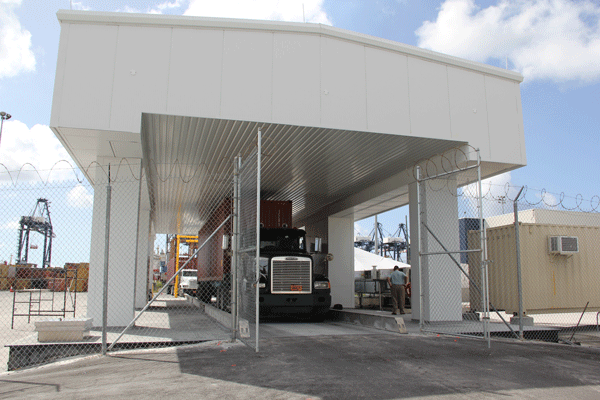
Costs
The initial acquisition cost of a Muon Tomography system for Customs NII purposes will be approximately twice the cost of a standard High Energy X-Ray system. I would suggest, however, that the important cost that should be considered is the Total Cost of Ownership (TCO) over the equipment lifetime. The Muography system has no moving parts with no radiation protection walls/building needed; its annual maintenance cost is minimal, with experience shown to be, on average, only about 30% that of a typical HE X-ray system. This significantly reduced annual cost easily translates to a considerable savings to the Customs administration. Mapping and considering the running and acquisition costs together, the conventional X-ray system and Muography system reach a comparable level of cost in year 5 of an average 15 year expected lifespan, with the Muography system thereafter costing significantly less in real terms year on year with all the advantages that come with it: No harmful radiation, 3D imagery and unrivalled penetration leading to an assured probability of detection.
Case studies
The applications of DL algorithms in the field of Muon Tomography are very real and available today.
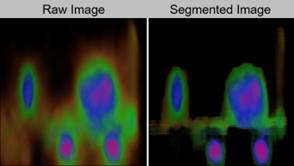 One simple example of Image Segmentation applied to Muon Tomography data is shown in the image on the left, where the models have been trained to identify voxels filled with material versus those filled only with air, allowing the system to clean up signal smear and produce a much clearer image. The images show a side view of the rear portion of a cargo container and trailer. The two trailer wheels and axles are visible at the bottom of the images, directly above them is a pallet of gravel, and in front is a three-tonne block of granite. In the raw image, cloudiness is visible throughout the image surrounding the materials, an artifact of the reconstruction algorithms used to produce the image. In the segmented image, the materials have been separated from the surrounding air and the signal smear is removed, producing a much sharper image for an operator to inspect.
One simple example of Image Segmentation applied to Muon Tomography data is shown in the image on the left, where the models have been trained to identify voxels filled with material versus those filled only with air, allowing the system to clean up signal smear and produce a much clearer image. The images show a side view of the rear portion of a cargo container and trailer. The two trailer wheels and axles are visible at the bottom of the images, directly above them is a pallet of gravel, and in front is a three-tonne block of granite. In the raw image, cloudiness is visible throughout the image surrounding the materials, an artifact of the reconstruction algorithms used to produce the image. In the segmented image, the materials have been separated from the surrounding air and the signal smear is removed, producing a much sharper image for an operator to inspect.
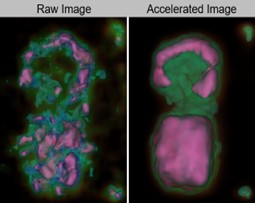 An example of the application of Image Acceleration to Muon Tomography data is shown in the image on the left. It shows two pallets of gravel from a top view perspective. The lower pallet consists entirely of gravel, while the upper pallet contains a fentanyl surrogate embedded inside. The raw image was created from the analysis of muon data collected over 60 seconds. It shows significant variation in signal intensity, resulting in a “noisy” appearance. The accelerated image was created by applying the accelerated imaging models. The signal variation is greatly reduced, providing the operator with an image of much higher quality and clarity.
An example of the application of Image Acceleration to Muon Tomography data is shown in the image on the left. It shows two pallets of gravel from a top view perspective. The lower pallet consists entirely of gravel, while the upper pallet contains a fentanyl surrogate embedded inside. The raw image was created from the analysis of muon data collected over 60 seconds. It shows significant variation in signal intensity, resulting in a “noisy” appearance. The accelerated image was created by applying the accelerated imaging models. The signal variation is greatly reduced, providing the operator with an image of much higher quality and clarity.
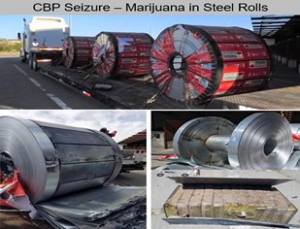 A real-world example of the use of Image Acceleration comes in the context of a seizure by U.S. Customs and Border Protection (CBP) of more than two tonnes of marijuana at the Mariposa Port of Entry along the U.S.-Mexico border. The method of smuggling in this instance was to conceal drugs inside metal containers, weld them shut, then conceal these containers inside large rolls of sheet metal. This elaborate process produces large interior volumes for concealing contraband shrouded in metal and presents a significant detection challenge using X-ray systems.
A real-world example of the use of Image Acceleration comes in the context of a seizure by U.S. Customs and Border Protection (CBP) of more than two tonnes of marijuana at the Mariposa Port of Entry along the U.S.-Mexico border. The method of smuggling in this instance was to conceal drugs inside metal containers, weld them shut, then conceal these containers inside large rolls of sheet metal. This elaborate process produces large interior volumes for concealing contraband shrouded in metal and presents a significant detection challenge using X-ray systems.
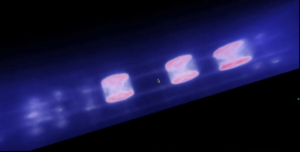 The truck passed through a 6 MeV X-ray system which generated an image showing only a black dense area. The truck also passed through a Muography system which generated the image on the right clearly showing an anomaly in the internal structure of the steel rolls. Reconstructing an image takes as little as 30 seconds, and is fully available within three minutes on the operator’s workstation.
The truck passed through a 6 MeV X-ray system which generated an image showing only a black dense area. The truck also passed through a Muography system which generated the image on the right clearly showing an anomaly in the internal structure of the steel rolls. Reconstructing an image takes as little as 30 seconds, and is fully available within three minutes on the operator’s workstation.
 To the left are two images of one of the steel rolls. Again, a “noisy” appearance is seen in the raw image, while the accelerated image is much clearer. The internal structure of the steel rolls is clearly visible to an operator.
To the left are two images of one of the steel rolls. Again, a “noisy” appearance is seen in the raw image, while the accelerated image is much clearer. The internal structure of the steel rolls is clearly visible to an operator.
DL models based on the Region of Interest / Volume of Interest method are broad, as there are many reasons to consider a region “interesting.” A volume with an identifiable object within it, or other notable substructure indicative of an anomaly, may be considered of interest. A volume/region might also be of interest if it differs from the other volumes in a container. Once manifest data becomes available and is integrated into the analysis, it will be possible to identify items or materials which are not listed in the manifest.
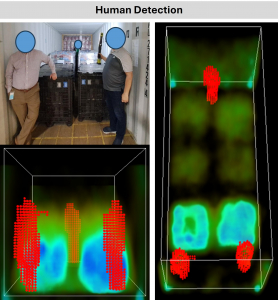 One exciting application of the VOI method is for detecting the presence of human beings. Humans produce a recognizable signature when muons and electrons pass through them and a human detection ML model has been developed to detect their presence within a cargo consignment. The image on the left shows an example of this capability. Three men are standing in various positions in a cargo container filled with pallets of material throughout. The reconstructed images of the container clearly show the three human figures in red.
One exciting application of the VOI method is for detecting the presence of human beings. Humans produce a recognizable signature when muons and electrons pass through them and a human detection ML model has been developed to detect their presence within a cargo consignment. The image on the left shows an example of this capability. Three men are standing in various positions in a cargo container filled with pallets of material throughout. The reconstructed images of the container clearly show the three human figures in red.
By utilizing DL models and advanced image processing techniques, Muon Tomography can quickly and accurately identify anomalies in cargo, reducing false alarms and increasing the probability of detection. As the technology supporting them continues to evolve and authorities provide access to key data, these passive and SAFE systems promise to play a critical role in safeguarding global trade and ensuring the safety of people and the integrity and security of supply chains.
More information
www.DecisionSciences.com
info@DecisionSciences.com

